
Related
|
|
Don't look at the opponent's eyes, or your mind will be drawn into his eyes. Don't look at his sword, or you will be slain with his sword. Don't look at him, or your spirit will be distracted. True budo is the cultivation of attraction with which to draw the whole opponent to you. All I have to do is to keep standing this way. Morihei Ueshiba
|
Richard Salmon Shihan
Founder of Budo Ryu Karate-do
I have been a close student of Salmon sensei since 1966. He has been my very first sensei and because of that perhaps the most important influence in my martial arts career. He was also the first person to introduce me to aikido. I would like to give special recognition to this extraordinary and charismatic leader and present him to my friends and students in the following pages.
-- Paul de Beer

Richard A Salmon Shihan (Hanshi) was the founder of the Budo Ryu System of Karate and the current head of the International Budo Karate Do organisation. He is ranked 1st Dan (Aikido), 1st Dan (Shotokan Karate), 2nd Dan (Judo), 2nd Dan (Goju-Ryu Karate), 5th Dan (Shukokai Karate) and 8th Dan Budo-Ryu Karate. Salmon sensei was also presented with the Diamond Award 1st Class as a Founder Father of South African Karate in 2003.
CITATION:
"The outstanding and selfless dedication displayed by Richard Salmon, in being one of the 1st Founder Fathers to introduce the South African public to the traditional Martial Sciences of the East as well as his life long dedication and ensuing dedication by caring for our fragile planet and environment and passing this knowledge onto the future generations, is noted and recognised by the South African Karate and Martial Arts Hall of Fame."
In 1968 Richard Salmon was the 1st South African to have his style, Budo-Ryu, approved, recognised and sanctioned as a fully codified and workable martial art system by the World Karate Union.
The Early Years
Salmon Shihan: was born in Durban on the 28th November 1939. After high school he graduated at the South African Nautical College, General Botha, and spent time at sea as a Junior Navigation Officer.
In 1955 Salmon sensei was introduced to the Martial Arts by Pearson Widdicombe (1st Dan Judo) at the old Kodokwai Dojo in Durban. He progressed rapidly and opened up his 1st Dojo, calling it the Budokan. As there were no high ranking Judo-Ka or Martial Arts Practitioners available in South Africa to teach at that time, he decided to visit the many Japanese, Okinawan and Korean cargo and passenger ships and fishing trawlers that regularly visited Durban to look for Japanese teachers who may help him advance. It was during this period, that he was presented with his first set of nunchaku from a Okinawan visitor. These were believed to be the first set seen in South Africa and which he still carries to this day.
It was also during this period that he had the good fortune to meet and train with Hennesy Sealy a 6th Dan instructor of Isshinryu, who gave him a memorable written message which reads: “Whatever you do, wherever you go, be constantly reminded of your self and the damage you can do. Rule the mind, which unless it obeys, commands.”
In 1961, during one of his regular visits to a passenger ship in the harbour which was taking Japanese immigrants to Brazil, he was introduced to Taniguchi Sensei, then 5th Dan Goju-Ryu. He trained up to 6 hours per day for the time the ship was in harbour. On his departure, Taniguchi sensei graded him to 1st Dan Goju-Ryu under the registration number: “AFRICA: 1” and invited him to visit him in Brazil.
Early in 1962 sensei left South African with Des Botes, a South Africa karate man who was also to become a legend in his time. They travelled by sea in steerage class (the cheapest way) to Brazil.
On board, they were delighted to find a Shotokan karate instructor by the name of Tanaka, a 3rd degree black belt. (Shotokan) The many hours of training each day, during the 3 week trip was “Extremely thorough and intense, but invaluable”.
In Brazil, they joined Taniguchi Sensei at his dojo in Sao Paulo and lived with his Japanese students. At the end of this period he was graded Nidan in Gojuryu karate.
1962 also saw the arrival of Kase Sensei (6th Dan Shotokan) in South Africa.
Richard Salmon, Stan Schmidt and many other karate-ka who were to become household names in later years, trained at the old Kodokwai JKA dojo, which was then situated in the Esplanade, Durban. The dojo was owned by George Higginson, who was involved with other JKA dojo’s in bringing Sensei Kase to South Africa.
At the end of this extended training period Salmon sensei was promoted to the degree of 1st Dan Black Belt in Shotokan karate. Richard Salmon and Stan Schmidt were by then considered to be the leading Karate practitioners in South Africa. They soon became respected friends.
By this time the Budokan had gathered a large following of both Judo-ka and Karate-ka and branch dojos had opened up in Durban, Westville, Kearsney College and Highbury School. (Hillcrest), followed by Bethlehem, Bloemfontein and Pietermaritzburg. Salmon sensei was now instructing full time.
During this time, the Karate Association Republic of South Africa (KA RSA) was founded and Salmon sensei was invited to join as its Chief Instructor. This appointment resulted in sensei being invited to dozens of dojo’s around the country. Many of these dojos later joined the Budokan SA organisation.
During 1964 the Karate Association: Republic of South Africa (KA RSA) selected a team to tour with Richard Salmon as team leader. This was the 1st karate team to have represented South Africa.
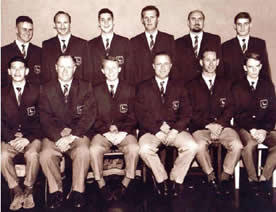

Later, during 1965/66, the head of the Shukokai Karate and the World Karate Union “WKU”, Hanshi Chojiro Tani, 8th Dan, was invited to South Africa. His visit was followed by Fugiwara Sensei, 7th Dan, Chief Instructor of the WKU Teaching Department and later also Kimura Sensei, 6th Dan from the Shukokai Hombu dojo. Over the next 18 months Richard Salmon and his great friend Des Botes, did intense training with these Sensei. At the end of this period Salmon was graded to Sandan in Shukokai Karate by Hanshi Tani , was invited to train with him at his Head Quarters in Hyogo, Kobe, Japan and gladly accepted the invitation.
Later, at the Hyogo Dojo they trained with some of the worlds top Shukokai instructors, including Kimura 6th Dan and of course the Great Karate Master himself, Hanshi Tani. Sensei was also invited to train at the Head Quarters Dojo of the World Karate Union Teaching Department in Himeji, Western Japan, where the Chief Shukokai Instructor, Fugiwara (7th Dan) was based. To be invited to train at this dojo, you were supposed to hold the grade of at least 4th Dan. At the end of a few very tough months of training Salmon was promoted to 4th Dan in Shukokai Karate, by Hanshi Tani and became the 1st Westerner to be made an official member of the WKU Teaching Department.
During his visit to Tokyo he trained at the “Kodokan”, World Head Quarters for Judo, in which he holds a 2nd Dan Black Belt. Here he was honoured to attend a training session under the instruction of Kyuzo Mifune 10th Dan, one of the great Judo Sensei’s of all time. Mifune was in his 80’s at the time.
On reflection Salmon sensei says that although he was honoured to have trained with some of the greatest Martial Arts [Karate & Judo] masters of all time, he believes the Greatest of them all (also purely as a man) was O’Sensei Morihei Uyeshiba, Founder of Aikido. If ever there was a Saint and a Gentleman, this man was one. He was so humble, yet so strong in mind and body. He was a very small man in stature, BUT the biggest man I ever met. I was moved emotionally by just being in his presence and what a wonderful lifetime memory it was, having had him accept me. While at the Aikido-Hombu, Salmon trained with O’Sensei’s son, Kisshomaru Ueshiba. At that time, O’Sensei was 86 years old.

It is of importance to note, that during this pilgrimage to Japan Salmon and his close friend Ray Ryan also had the great honour of training under Yamaguchi Gogen “The Cat”, 10th Dan and founder of Goju-Kai karate, Matsutasu Oyama 10th Dan and founder of Kyokushinkai, also Masatoshi Nakayama ,8th Dan, Chief JKA instructor and three of the great JKA Champions, Keinesuke Enoeda, H. Nishiyama and H. Kanizawa. It is thought that very few Westerners, if any, had had the opportunity to train with so many legends.
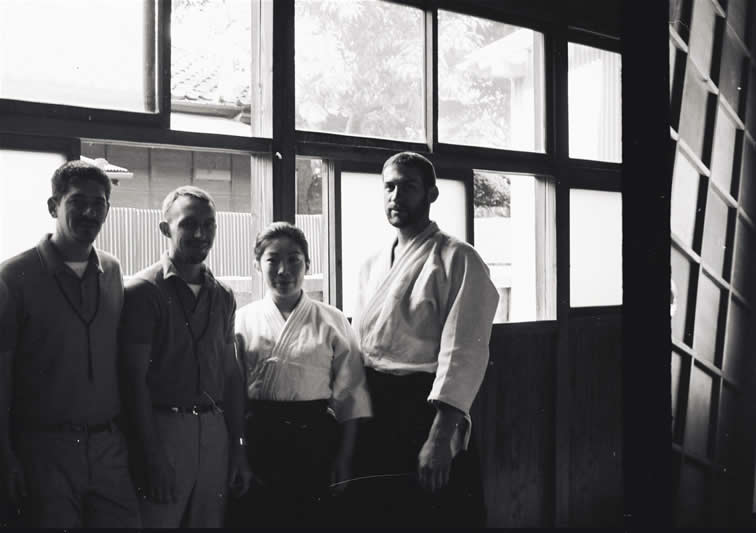
One of the most thought provoking visits of the whole trip was their visit to Hiroshima and the Atomic Bomb Peace Park Museum, especially to the Children’s Memorial.
It had such an effect on him to see what man is prepared to do to man, and especially the children. It had such an effect on him that he shed tears. It changed his perspective on life and the purpose of humanity. It led him to eventually devote his later life to the conservation of our planet and the creation that share it with mankind.
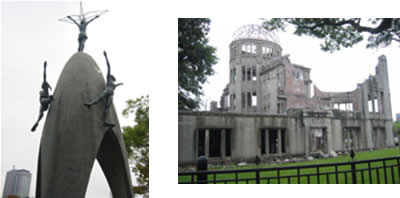
With South Africa’s expulsion from the Olympic Games, the then Ministry of Sport decided to hold the South African Games (which has been held at fairly regular intervals ever since) and Shihan Richard Salmon, James Rousseau and Stan Schmidt, were asked to put the karate section of these games together. These 3 great Karate Masters were installed as Chief Referees for South Africa at these games and continued to work together in this position for many years. At the 1st South African Games (held in Bloemfontein), Salmon gave the first ever public demonstration seen in South Africa of the Sai and together with his great friend Ray Ryan, also gave the first ever public demonstration seen in the country of Katana in the form of A FIGHTING KATA.
Other historic highlights that were of significance included:
1968: Salmon had for a great many years, been working on his own system, which encapsulated all he had learnt from a great many Martial Arts Masters. This system named “Budoryu”, was presented in the form of a Thesis to Hanshi Tani for consideration, in order to gain International acceptance for his new style. This Thesis was accepted and Salmon was promoted to the degree of 5th Dan Black Belt and with this the “South African Whos Who of Sport”, reflects Salmon as the 1st South African to achieve the rank of 5th Dan Black Belt. As the now World Head of his own system, Salmon was awarded the title of Hanshi (which technically carries with it, the grade of 8th Dan) by the Budokan SA Black Belt Association, A title which was humbly accepted, but as he said at the time, “I never really accepted this as a rank for it has always been my philosophy that it is not the belt or rank that counts, but the quality of the man inside. I just hope I can live up to that quality and the honour bestowed on me”
1970’s: During the early 1970’s, Salmon and his wife Dot felt the call to further their aims of helping society and our planet. The reins of Budokan SA and the Budoryu style were handed over to Ray Ryan and Salmon and his wife moved into the mountains to develop the SA Mountain Leadership School. This project was aimed at helping young people through the challenges of the outdoors and to give them a better understanding of our planet and their responsibility in making it a better place for future generations.
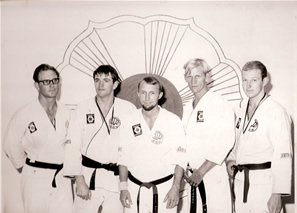
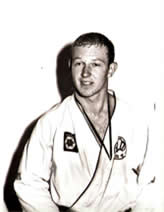
1977: Sensei and his wife Dot left South Africa for the USA. Budoryu was then introduced to the USA, at a private school outside Dallas, Texas. Shortly thereafter, it was introduced into England by Dave Passmore. (3rd Dan) who in 2010 celebrated his 40th anniversary of Budokan UK.
1977 - 2000: During the next 23 years, Salmon and his wife developed a great many projects in support of the environment, children around the world and world wild life. For this great, outstanding and valuable contribution to our world and its systems the Salmons received the support and recognition of the following world leaders:
H.R.H: Prince Phillip, H.R.H: Prince Berhard of the Netherlands (the Salmons have been entertained in the palaces of both Princes, one, Buckingham Palace in London and the other, at Soestdijk, Netherlands). Certificates of commendation from USA Presidents, Carter and Reagan. The support of then Vice-President and future President, George Bush Snr:, the Governor and future President, Bill Clinton and 43 US State Governors. They were written into the Congressional Records of the US Senate and received the personal blessings of His Holiness Pope John Paul. The Salmons were also honoured with their own ceremony at the United Nations Head Quarters in New York, for one of their World Children’s Programs.